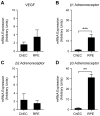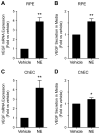Attenuation of choroidal neovascularization by β(2)-adrenoreceptor antagonism
- PMID: 23303344
- PMCID: PMC3652586
- DOI: 10.1001/jamaophthalmol.2013.1476
Attenuation of choroidal neovascularization by β(2)-adrenoreceptor antagonism
Abstract
Objectives: To determine whether β-adrenergic blockade inhibits choroidal neovascularization (CNV) in a mouse model of laser-induced CNV and to investigate the mechanism by which β-adrenoreceptor antagonism blunts CNV.
Design: Mice were subjected to laser burns, inducing CNV, and were treated with daily intraperitoneal injections of propranolol hydrochloride. Neovascularization was measured on choroidal-scleral flat mounts using intercellular adhesion molecule 2 immunofluorescence staining. The effect of β-adrenoreceptor signaling on expression of vascular endothelial growth factor (VEGF) was investigated using primary mouse choroidal endothelial cells (ChECs) and retinal pigment epithelial (RPE) cells. These cells were incubated with β-adrenoreceptor agonists and/or antagonists and assayed for Vegf messenger RNA and protein levels.
Setting: University of Wisconsin School of Medicine and Public Health.
Participants: Wild-type 6-week-old female C57BL/6j mice.
Main outcome measures: Inhibition of CNV after propranolol treatment and Vegf messenger RNA and protein expression after treatment with β-adrenoreceptor agonists and antagonists.
Results: Propranolol-treated mice demonstrated a 50% reduction in laser-induced CNV. Treatment with norepinephrine bitartrate stimulated Vegf messenger RNA expression and protein secretion in ChECs and RPE cells. This effect was blocked by β2-adrenoreceptor antagonism and mimicked by β2-adrenoreceptor agonists.
Conclusions: Attenuation of CNV is achieved by β-adrenergic blockade. The β2-adrenoreceptors regulate VEGF expression in ChECs and RPE cells.
Clinical relevance: Antagonists of β-adrenoreceptors are safe and well tolerated in patients with glaucoma and cardiovascular disease. Thus, blockade of β-adrenoreceptors may provide a new avenue to inhibit VEGF expression in CNV.
Figures





Similar articles
-
β2-Adrenergic Receptor Antagonism Attenuates CNV Through Inhibition of VEGF and IL-6 Expression.Invest Ophthalmol Vis Sci. 2017 Jan 1;58(1):299-308. doi: 10.1167/iovs.16-20204. Invest Ophthalmol Vis Sci. 2017. PMID: 28114591 Free PMC article.
-
Propranolol Attenuates Proangiogenic Activity of Mononuclear Phagocytes: Implication in Choroidal Neovascularization.Invest Ophthalmol Vis Sci. 2019 Nov 1;60(14):4632-4642. doi: 10.1167/iovs.18-25502. Invest Ophthalmol Vis Sci. 2019. PMID: 31682714
-
TNF-α mediates choroidal neovascularization by upregulating VEGF expression in RPE through ROS-dependent β-catenin activation.Mol Vis. 2016 Feb 3;22:116-28. eCollection 2016. Mol Vis. 2016. PMID: 26900328 Free PMC article.
-
Laser-induced choroidal neovascularization in mice attenuated by deficiency in the apelin-APJ system.Invest Ophthalmol Vis Sci. 2013 Jun 21;54(6):4321-9. doi: 10.1167/iovs.13-11611. Invest Ophthalmol Vis Sci. 2013. PMID: 23722395
-
Association Between β-Adrenoreceptor Agonists and Antagonists and Parkinson's Disease: Systematic Review and Meta-Analysis.Pharmacoepidemiol Drug Saf. 2025 Apr;34(4):e70140. doi: 10.1002/pds.70140. Pharmacoepidemiol Drug Saf. 2025. PMID: 40200766 Free PMC article.
Cited by
-
Biphasic effects of propranolol on tumour growth in B16F10 melanoma-bearing mice.Br J Pharmacol. 2017 Jan;174(2):139-149. doi: 10.1111/bph.13662. Epub 2016 Nov 30. Br J Pharmacol. 2017. PMID: 27792834 Free PMC article.
-
Use of β‑blockers and risk of age‑related macular degeneration among hypertensive patients: An insight from The National Health and Nutrition Examination Survey.Med Int (Lond). 2023 Jan 30;3(1):10. doi: 10.3892/mi.2023.70. eCollection 2023 Jan-Feb. Med Int (Lond). 2023. PMID: 36793623 Free PMC article.
-
Fingolimod (FTY720), a Sphinogosine-1-Phosphate Receptor Agonist, Mitigates Choroidal Endothelial Proangiogenic Properties and Choroidal Neovascularization.Cells. 2022 Mar 11;11(6):969. doi: 10.3390/cells11060969. Cells. 2022. PMID: 35326420 Free PMC article.
-
EFFECT OF INTRAOCULAR PRESSURE-LOWERING MEDICATIONS ON NEOVASCULAR AGE-RELATED MACULAR DEGENERATION TREATMENT OUTCOMES IN THE COMPARISON OF AGE-RELATED MACULAR DEGENERATION TREATMENT TRIALS.Retina. 2019 Apr;39(4):636-647. doi: 10.1097/IAE.0000000000002124. Retina. 2019. PMID: 29517580 Free PMC article. Clinical Trial.
-
Monocyte-Derived Macrophages Are Necessary for Beta-Adrenergic Receptor-Driven Choroidal Neovascularization Inhibition.Invest Ophthalmol Vis Sci. 2019 Dec 2;60(15):5059-5069. doi: 10.1167/iovs.19-28165. Invest Ophthalmol Vis Sci. 2019. PMID: 31800964 Free PMC article.
References
-
- Lim LS, Mitchell P, Seddon JM, Holz FG, Wong TY. Age-related macular degeneration. The Lancet. 2012;379(9827):1728–1738. - PubMed
-
- Lopez PF, Grossniklaus HE, Lambert HM, et al. Pathologic features of surgically excised subretinal neovascular membranes in age-related macular degeneration. American Journal of Ophthalmology. 1991;112(6):647–656. - PubMed
-
- Grossniklaus HE, Martinez JA, Brown VB, et al. Immunohistochemical and histochemical properties of surgically excised subretinal neovascular membranes in age-related macular degeneration. American Journal of Ophthalmology. 1992;114(4):464–472. - PubMed
-
- Thomas JW, Grossniklaus HE, Lambert HM, Aaberg TM, L’Hernault N. Ultrastructural features of surgically excised idiopathic subfoveal neovascular membranes. Retina (Philadelphia, Pa ) 1993;13(2):93–98. - PubMed
-
- Lopez PF, Lambert HM, Grossniklaus HE, Sternberg P. Well-defined subfoveal choroidal neovascular membranes in age-related macular degeneration. Ophthalmology. 1993;100(3):415– 422. - PubMed
Publication types
MeSH terms
Substances
Grants and funding
LinkOut - more resources
Full Text Sources
Other Literature Sources

